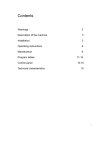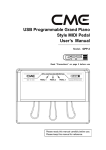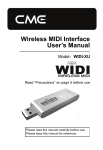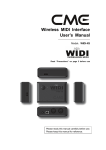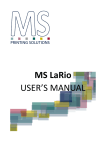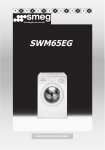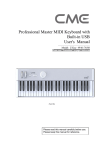Download Smeg 633ST Washer User Manual
Transcript
smeg Istruzioni per l'uso e l'installazione Instrucciones para el uso Notice d'utilisation User's book 1 CONTENTS 1-3 ➤ DESCRIPTION OF THE MACHINE ➤ SAFETY 2 ➤ INSTALLATION 3 ➤ WARNINGS 3 ➤ SETTING-UP THE MACHINE 4 ➤ ELECTRICAL CONNECTION 4 ➤ WATER CONNECTION 4 5 ➤ USEFUL ADVICE 6 ➤ CLOTHING CARE LABELS 7 ➤ BEFORE WASHING 8 ➤ MAINTENANCE 9 ➤ TROUBLESHOOTING DESCRIPTION OF THE MACHINE 1 2 3 1 - GLASS DOOR 2 - DRUM 3 - SCRATCHPROFF TOP 4 - ADJUSTABLE FEET 5 - FILTER 4 5 ENGLISH GB 2 Thank you for having chosen our product. This appliance is safe and easy to use. It has been constructed according to international safety standards designed to protect the user. In order to familiarise yourself with the machine and ensure its long working life, we strongly recommend that you read this instruction manual carefully. SAFETY ✔ The machine must not be installed outdoors, even if protected by a roof, in that atmospheric agents may cause irreparable damages. ✔ This appliance has been designed for use as a domestic washing machine. Any other use is considered as improper and therefore dangerous. ✔ Do not pull the power cable or appliance to remove the plug from its socket. ✔ Do not use detergents designed for hand washing, in that the excessive suds produced could damage the internal components. ✔ The appliance must only be used by adults. ✔ When the appliance is in operation, avoid any contact with the water being discharged through the drain hose, as it may be very hot. ✔ The appliance is very heavy and requires utmost care when being moved. ✔ Do not touch the door glass, as this will tend to heat up during a wash. ✔ If the machine is to stand on a carpeted floor, ensure that there is sufficient space for air to circulate between the floor and the bottom of the machine. ✔ At the end of the wash, wait approximately three minutes before opening the door, as it is fitted with a safety device that prevents it from being opened accidentally. ✔ The appliance must not be used or touched barefoot or with wet or damp hands or feet. ✔ When positioning the appliance, ensure that the power supply cable is not kinked or squashed and is accessible. ✔ If it becomes necessary to replace the power supply cable, refer exclusively to an authorised service centre. ✔ Do not use extension leads, especially in a damp atmosphere. GB ✔ It is advisable to leave the door open after completion of the wash cycle. ✔ In the case of faulty operation, switch off the machine by removing the plug from its socket using dry hands. Never try to access internal components or attempt to repair the machine, instead refer exclusively to an authorised assistance centre. 3 DESCRIPTION OF THE MACHINE The washing machine is a domestic appliance capable of washing any type of fabric at any time. ✔ The machine has been constructed in steel panels which have been treated and painted to guarantees that its aesthetic qualities remain unaltered over time. ✔ The motor and all moving parts have been designed and manufactured to guarantee the minimum possible noise levels. ✔ The large well-mounted stainless steel drum will ensure a better quality wash and help to prolong the life of your washing. ✔ The easy to use control panel will satisfy all your washing and drying needs (see control panel and programme table). ✔ The wide door makes loading and unloading your washing much easier. ✔ The very high stability of the machine is the result of extensive research by our technicians on the equilibrium of masses in movement. INSTALLATION Installation must be carried out by qualified personnel in line with the instructions supplied by the manufacturer. Incorrect installation may result in damage and injury. The machine can be installed anywhere providing the ambient temperature is not less than 3°C and the wires or pipes on the rear of the machine are not squashed. WARNINGS V ▼ For transport reasons, the machine’s oscillating group is locked in place by 4 spacers and screws. Before using the machine, remove the spacers and locking screws. Keep the screws and spacers for future use. ▼ Close off the holes using the plugs supplied. The plugs can be found in the bag containing the documents. N.B. If the spacers cannot be removed from the machine in this way, open the rear panel, remove them and replace the panel. ▼ For transport reasons, the machine’s oscillating group is locked in place by 4 spacers and screws. Before using the machine, remove the locking screws with a suitable spanner. ▼ Insert a screwdriver in the holes and lever out the 4 plastic spacers as shown in the figure. N.B. If the spacers cannot be removed from the machine in this way, open the rear panel, remove them and replace the panel. GB 4 SETTING-UP THE MACHINE ▼ Place the machine near to the connection points and ensure that it is level. To do this, adjust the feet by screwing or unscrewing them as required. When the machine is level, tighten the lock nuts on the feet using a spanner. ELECTRICAL CONNECTION ▼ Check that the power supply and socket are correctly sized for the maximum load demand of your machine. The power supply voltage is indicated on the rating plate affixed to the filter door on the bottom right of the washing machine. The mains electricity supply must be equipped with an earth. If this requirement is not complied with, the manufacturer will not be held liable for any resulting damage or injury. WATER CONNECTION ▼ Allow a good quantity of water to flow out of the system until it is clear and free of impurities, especially if the plant is new or has not been used for some time. Connect the water inlet pipe to the valve, inserting the filter/washer supplied. Check that the other end of the pipe is tightened properly. Position the drain hose between a minimum of 60 cm and a maximum 90 cm from floor level. N.B. To prevent siphoning, do not make the machine drain hose connection air tight. If the water system is not provided with a drain, use the bracket supplied to position the drain pipe over a washbasin then tie it to a tap. Do not use old or used fill hoses. Use only those supplied with the machine. A MIN. MAX 60 CM .90 CM GB 5 USEFUL ADVICE ✔ Separate the washing according to type of fabric. ✔ Wash coloured and white articles separately. ✔ Check the clothing care labels affixed to the articles and set the appropriate programme and temperature. ✔ In order to obtain good results from the wash, distribute the washing evenly inside the machine alternating small items with larger ones. ✔ In order not to waste water, energy and detergent, it is advisable to load the machine to its maximum recommended capacity. ✔ Do not use the pre-wash unless it is strictly necessary. This will reduce water, energy consumption and time by an average of 10%. ✔ Try to avoid overloading the machine with articles in towelling only. ✔ Carefully check that there are no object left in the pockets of the articles that may block the drain pump. Stains exist that cannot be removed by machine washing alone. The following paragraphs describe how to pre-treat stained fabrics before loading them in the machine. This will help prevent an unsuccessful wash and the formation of stain rings. ✔ Wax: Scratch away as much of the wax as possible using a blunt knife, then iron with a piece of silk paper between the iron itself and the stained item. ✔ Ball-point and felt-tip pens: Dab the stain with a cloth damped with 90° colourless alcohol. Take care not to increase the stain. ✔ Rust: Use a rust remover, carefully following the manufacturer’s instructions. ✔ Chewing gum: Dilute it with acetone and remove using a clean cloth. ✔ Paint: Do not allow the paint to dry. Treat it immediately with the solvent indicated on the paint container (water, turps, trichloroethylene), soap it and rinse. ✔ Lipstick: Dab it with ether if the stain is on wool or cotton or use trichloroethylene if on silk. ✔ Nail varnish: Place the stained part of the item over a sheet of absorbent paper and then dampen the reverse side of the item with acetone, frequently changing the absorbent paper under the stain. Repeat the procedure until the stain has disappeared. ✔ Metal stain: Apply lemon juice until the stain has disappeared or greatly reduced in intensity. ✔ Grass: Soap it delicately and treat with diluted bleach. For woollen items, 90° alcohol can produce good results. GB 6 HOW CAN I WASH ALMOST ANYTHINGS Tennis shoes: tennis shoes or plimsolls can be machine washed. Just remove any mud from them before starting the wash cycle. Curtains: should be washed alone. They should first be folded to stop them creasing excessively and then placed in a net bag or pillow case. Quilted wind-cheaters: can be machine-washed. In this case limit the maximum machine load to just over 50%. It is also advisable to carry out an extra rinse at the end of the wash cycle. Printed T-shirts and shirts: will last longer if washed inside-out. CLOTHING CARE LABELS Learn to recognise the symbols on the clothing care labels to obtain a better wash and ensure that the articles have a longer life. Washing Bleach Ironing cl Resistant fabric Bleach in cold water Dry cleaning Drying A Iron up to 200° max Dry clean with solvent Dry flat P Delicate fabric 95 Do not dry clean Iron up to 100° max Dry clean only with: perchloride, aviation fuel pure alcohol, R111 and R113 Dry on clothes hanger Dry clean only with: aviation fuel, pure alcohol and R113 Machine dry at normal temperature 40 Hang to dry F 60 Wash up to 60°C 40 Iron up to 150° max 95 Wash up to 95°C 60 Do not bleach Do not iron Wash up to 40°C Machine dry at low temperature Hand wash Do not machine dry 30 30 Wash up to 30°C Do not wash in water GB 7 BEFORE WASHING closed Before each wash ensure that: open ✔ the water connections are correct, the drain hose is properly positioned (see water connection) and that the feed valve is open. ✔ with dry hands, insert the plug in the mains socket. ✔ sort the wash into types of fabric (refer to clothing care symbols). ✔ check that there are no objects left in any of the pockets of the items to wash, as these may damage the washing, the appliance or the filter. ✔ open the door. ✔ load the washing and close the door. YES NO ▼ N.B. When adding detergent to the dispenser, remember to avoid any spillage into the softener compartment, in that this would create a soapy rinse and stain the fabrics white. Vice versa, if softener is added to the detergent compartment, the quality of the wash will be compromised. ▼ N.B. When using a liquid detergent (recommended for programmes without pre-wash), use the special container (if provided) and follow the manufacturer’s instructions. Remember to remove the liquid detergent container when using soap powder. ✔ add low-suds detergent and softener (if required) recommended for automatic washing machines. Follow the dosage instructions written on the packet. N.B. Excessive softener can damage the washing. ✔ close the detergent dispenser drawer. Warning! Do not attempt to remove the detergent drawer while the appliance is operating, as this will cause water to flow out. ✔ select the required programme and temperature according to the programme table. GB 8 MAINTENANCE INTRODUCTION ▼ The washing machine is a domestic appliance that does not need any particular maintenance, in that it has been designed to last. Nevertheless, it is advisable to take one or two precautions. The external structure and the parts of the washing machine in plastic must be cleaned with a soft damp cloth only. WARNING!! Never use chemicals, abrasive products, alcohol, soap, petrol or other solvents to clean the appliance as these may cause damage. PERIODICALLY CLEAN THE DETERGENT DRAWER ▼ The drawer must be cleaned whenever there are detergent residues present. The detergent drawer can be removed by pulling it out and pressing up from underneath at the same time. CLEANING THE PUMP FILTER ▼ This operation should be carried out at least once a month. Make sure that there is no water in the drum. Place a shallow basin or rag under the filter door to catch any water that may be left in the filter compartment. The filter can be removed by rotating it anticlockwise half a turn and pulling outwards. Clean the filter under running water, making sure that all the deposits are removed. Replace the filter in its housing by screwing it in clockwise, Make sure it is properly seated and locked in place. GB 9 TROUBLESHOOTING Before calling the assistance service, check that the operations described below have been carried out correctly; this will save both time and money. The machine does not work (indicator light off) Make sure that: 1) The electricity supply has not been cutoff 2) The plug is inserted properly in the socket 3) The programmer knob has been pulled outwards or the start/stop button (if fitted) has been pressed (see using the washing machine) 4) The door is closed. The machine does not fill with water Make sure that: 1) There is water in the mains supply 2) The feed valve is open 3) The fill hose is not kinked 4) With the machine unplugged from the mains, clean the inlet filter between the valve and the water fill hose. The machine will not drain or spin Make sure that: 1) The drain hose is positioned correctly 2) The drain hose is not kinked 3) The detergent dose is correct and not excessive 4) The detergent drawer is not caked-up 5) The detergent is the correct one for use in washing machines. The door will not open Wait 3 minutes after the programme has finished. model 220 V N ° 204276237 Hz kg wash kg dry 5 / 100 N/cm A total w 2 heating wash heating dryer wash motor spin motor dryer motor pump W W W W W W The machine does not work (indicator light on) Make sure that: 1) The programmer knob is set at the required programme 2) See problem “The machine does not fill with water". I cannot see any water during the wash This is simply because the new technology used in these machines guarantees double the wash with half the water, this benefits the environment and you save energy. I can see too much foam Make sure that: The detergent used is that designed for washing machines. The machine vibrates or is noisy Make sure that: 1) Large items in the wash are not folded (sheets, tablecloths, etc.) 2) The washing machine is properly levelled 3) The four locking screws and spacers have been removed. Does not dry (WASHER DRYER) Make sure that: 1) The programme has been chosen correctly 2) The water tap is turned on 3) The discharge filter is clean 4) The washing load is right. Try the machine to see if the problem has been solved. If the problem persists, call the technical assistance service, stating: 1) The type of malfunction 2) The model of the washing machine 3) The serial number of the machine reported on the rating plate fixed to the inside of the filter door. service GB 461304913 02-04-2003 E. Crialesi s.r.l. - Fabriano smeg 1 Wash programmes Detergent drawer Function buttons On/Off light Timer knob (P) Temperature knob (K) USING THE WASHING MACHINE Add the detergent and softener following the doses recommended by the manufacturer. Open the water fill valve. Select the required program by rotating the programmer knob clockwise. Select the temperature using the temperature control (if present) according to the load. Select the function buttons according to the model, then press the On/Off button (where present) or pull the programmer knob outwards. The power on indicator will light up. At the end of the wash cycle, press the On/Off button or, if this is not present, push the programmer knob inwards. The power on indicator light will switch off. Wait approximately 3 minutes before opening the door. DESCRIPTION OF FUNCTIONS ▼ Economy wash button This function limits lowers the temperature limit from 90°C to 60°C, while at the same time increasing the intensity of the wash for loads of less than 3 Kg of dry washing. ▼ Anti-crease button When this button is pressed, the machine will automatically stop with water still in the drum, thus preventing the washing from creasing. Press the button again to complete the wash cycle with a water drain and final spin. N.B. this function is only enabled for the “delicates/synthetics” and “wool” programmes. ▼ No-spin button Pressing this button will stop the wash cycle automatically (all programmes) without spinning. ▼ Half-load button Pressing this button will save water and energy when the wash load in the machine is approximately half of the maximum allowed. ▼ On/Off button Pressing this button starts the washing machine once all the other necessary operations have been carried out (see “Using the washing machine”). Eco 1/2 Detergent drawer Compartments: 1. Prewash detergent 2. Main wash detergent 3. Softener Temperature knob This is used to set the temperature of the wash based on the instructions in the programme table. The knob can also be set at 0°C to allow a cold wash. GB 2 PROGRAMME TABLE Knob (P) Label Prewash Main Softener Knob symbols wash (T) Examples and degree of soiling (model 633ST) Quantity kg Programme description Up to 3.5 Use of function buttons Eco 1/2 Pre-wash, wash, rinse, softener, drain and final spin As required As required As required Up to 3.5 Wash, rinse, softener, drain and final spin As required As required As required Up to 3.5 Wash, rinse, softener, drain and final spin As required As required For sheets, shirts, table cloths in delicate fabrics Up to 3.5 Wash, rinse, softener, drain and final spin As required As required 5 To rinse or refresh laundry in resistant fabric, unused for a long period of time Up to 3.5 Rinse, softener, drain and final spin As required As required 6 To rinse or refresh laundry Up to 3.5 Rinse, softener, drain and final spin As required 7 Fast spin Up to 3.5 Drain and final spin As required 1 max 90° min 30° 90 2 max 90° min 30° 90 3 max 60° min 30° 60 4 max 40° min 30° 40 For sheets, shirts, table cloths, towels, in heavily soiled resistant fabrics For sheets, shirts, table cloths, towels, in heavily soiled resistant fabrics For sheets, shirts, table cloths, towels, in average soiled resistant fabrics 8 max 60° min 30° 60 Heavily soiled synthetics with all kinds of stains Maximum 1,5 Pre-wash, wash, rinse, softener, drain and final spin As required As required As required 9 max 60° min 30° 60 White and colour-fast synthetics Maximum 1,5 Wash, rinse, softener, drain and final spin As required As required As required 10 max 40° min 30° 40 To rinse or refresh synthetics unused for a long period of time Maximum 1,5 Wash, rinse, softener, drain and final spin As required As required As required 11 max 40° Machine washable wool Maximum 1 Wash with high level water, rinse, softener, drain and final spin As required As required As required 12 To rinse or refresh synthetics unused for a long period of time Maximum 1,5 Rinse, softener, drain and final spin As required 13 To rinse or refresh laundry Maximum 1,5 Rinse, softener, drain and final spin As required 14 Delicate final spin Maximum 1,5 Drain and final spin As required 40 TECHNICAL CHARACTERISTICS (model 633ST) Dimensions Width 59.5 cm - Height 85 cm - Depth 33 cm Maximum recommended load during washing* Cotton 3.5Kg - Synthetics 1.5Kg - Wool 1Kg Max. spin 600 Rpm Water pressure min. 0.05 MPa - max. 1 MPa Maximum absorbed power Electrical connection See characteristics plate * To ensure that the wash load is evenly balanced in the machine and to avoid excessive vibration during spinning, the amount of washing must not be less than 1 kg. GB As required 3 PROGRAMME TABLE Knob (P) Label Prewash Main Softener Knob symbols wash (T) Examples and degree of soiling For sheets, shirts, table cloths, towels, in heavily soiled resistant fabrics For sheets, shirts, table cloths, towels, in heavily soiled resistant fabrics (model 839ST) Quantity kg Programme description Up to 5 Use of function buttons Eco 1/2 Pre-wash, wash, rinse, softener, drain and final spin As required As required As required Up to 5 Wash, rinse, softener, drain and final spin As required As required As required 1 max 90° min 30° 90 2 max 90° min 30° 90 3* max 60° min 30° 60 For sheets, shirts, table cloths, towels, in average soiled resistant fabrics Up to 5 Wash, rinse, softener, drain and final spin As required As required 4 max 40° min 30° 40 For sheets, shirts, table cloths in delicate fabrics Up to 5 Wash, rinse, softener, drain and final spin As required As required 5 To rinse or refresh laundry in resistant fabric, unused for a long period of time Up to 5 Rinse, softener, drain and final spin As required As required 6 Fast spin Up to 5 Drain and final spin As required 7 max 60° min 30° 60 Heavily soiled synthetics with all kinds of stains Maximum 2,5 Pre-wash, wash, rinse, softener, drain and final spin As required As required As required 8 max 60° min 30° 60 White and colour-fast synthetics Maximum 2,5 Wash, rinse, softener, drain and final spin As required As required As required 9 max 40° min 30° 40 To rinse or refresh synthetics unused for a long period of time Maximum 2,5 Wash, rinse, softener, drain and final spin As required As required As required 10 To rinse or refresh synthetics unused for a long period of time Maximum 2,5 Rinse, softener, drain and final spin As required 11 Delicate final spin Maximum 2,5 Drain and final spin Machine washable wool Maximum 1,5 Wash with high level water, rinse, softener, drain and final spin 13 To rinse or refresh laundry Maximum 2,5 Rinse, softener, drain and final spin As required 14 Delicate final spin Maximum 2,5 Drain and final spin As required 12 max 35° 35 As required As required As required As required As required * Reference program for power classification, in accordance with EN 60456 TECHNICAL CHARACTERISTICS (model 839ST) Dimensions Width 59.5 cm - Height 85 cm - Depth 39 cm Maximum recommended load during washing* Cotton 5Kg - Synthetics 2.5Kg - Wool 1.5Kg Max. spin 800 Rpm Water pressure min. 0.05 MPa - max. 1 MPa Maximum absorbed power Electrical connection See characteristics plate * To ensure that the wash load is evenly balanced in the machine and to avoid excessive vibration during spinning, the amount of washing must not be less than 1 kg. GB 461304914 02-04-2003 E. Crialesi s.r.l. - Fabriano
















